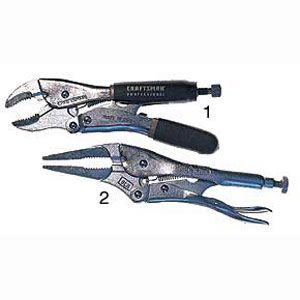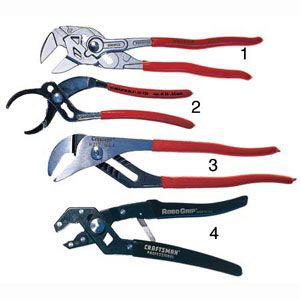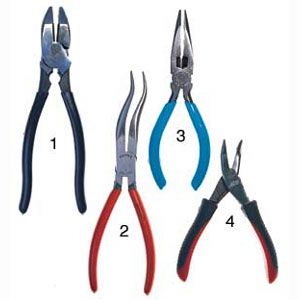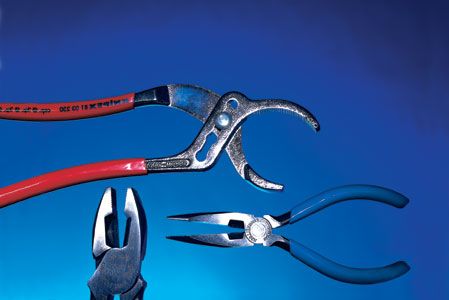Pliers are must-have tools that allow users to magnify holding strength and direct it to the precise point at which the jaws meet. There are many different types of pliers that homeowners can use, from locking pliers to curved-jaw pliers, and each serves a different purpose. No single pair of pliers can handle every job, and understanding the different types and their uses will help you to choose the right tool for your needs. Read our guide below to learn which pair of pliers to use for which jobs.

Locking Pliers
Locking pliers are versatile tools that allow users to grip workpieces securely without constant hand pressure. This allows users to multitask and concentrate on bending, pulling, or twisting while maintaining a solid grip. To use these pliers, simply grip the object, adjust the jaws using the screw at the handle base, then squeeze the handles to lock the jaws securely in place. Read more about different varieties below.
1. Curved-Jaw
Features: These pliers have curved, serrated jaws that wrap around round objects.
Best for: Locking pliers with curved jaws are best for freeing nuts and bolts that are stuck, pulling nails, removing broken screws, and various demolition tasks. They can also serve as a makeshift clamp.
2. Long-Nose
Features: Long-nose locking pliers have extended, serrated jaws that close tightly at the tips.
Best for: These pliers are best for getting an unbreakable grip on small objects such as staples, pins, and broken screws that are stuck in hard-to-reach places. They’re especially versatile, and you can handle most tasks with them.

Adjustable Pliers
Adjustable pliers feature jaws that you can set to various widths while maintaining a parallel grip. This design allows users to securely hold objects of different sizes without damaging surfaces. Read more about different varieties below.
1. Wrench-Plier
Features: These pliers feature a button-adjusted cam-and-ratchet mechanism that keeps the smooth jaws parallel no matter the handle position.
Best for: Wrench-pliers are best for turning bolts without stripping them and installing finished-metal plumbing fixtures. Their smooth jaws allow users to maintain a firm grip without marring surfaces.
2. Pipe-Gripping
Features: These pliers feature lightly serrated curved jaws and a four-point slip joint that users can easily adjust.
Best for: Pipe-gripping pliers are best for screwing and unscrewing plastic pipes without scratching or damaging them. The curved jaws allow users to easily grip them while addressing round surfaces.
3. Tongue-And-Groove
Features: These pliers feature large, serrated groove-joint jaws and long handles that offer users maximum leverage.
Best for: Tongue-and-groove pliers are best for tightening and loosening metal pipes and other plumbing connectors. They are especially useful for plumbing jobs.
4. Self-Adjusting
Features: These pliers feature a cam-and-ratchet mechanism that allows users to grip workpieces and automatically adjusts the jaws as you squeeze the handles.
Best for: Self-adjusting pliers are best for general repairs and plumbing tasks. They’re more reliable than all-purpose slip-joint pliers and can handle various object sizes without manual adjustment.

Non-Adjustable Pliers
Non-adjustable pliers feature fixed joints and are best for very specific tasks. They’re not as versatile as adjustable pliers, but they allow users to make very precise adjustments. Read more about different varieties below.
1. Lineman’s
Features: Lineman’s pliers have flat, toothed jaws and built-in wire cutters.
Best for: These pliers are best for grabbing, pulling, bending, and twisting solid electrical wire, rebar wire, and light sheet metal. They allow users to keep a firm grip, which is especially useful for electrical work.
2. Curved Needlenose
Features: These pliers feature long, pointed, S-shaped noses and lightly toothed jaws.
Best for: Curved needlenose pliers are best for tasks that involve inserting and removing small screws or other parts behind pipes, around corners, or in other hard-to-reach places. Their unique shape allows users to access tight spaces that straight pliers can’t reach.
3. Needlenose
Features: Standard needlenose pliers have lightly toothed jaws, a wire cutter, and a rounded back.
Best for: These pliers are best for delicately gripping small objects. They can help users to fish out dropped screws, twist stranded wires, or bend loops and eyes in solid wire. Use them for very precise tasks.
4. Bent Needlenose
Features: Bent needlenose pliers have small, pointed jaws, angled tips, a spring return, and soft handles.
Best for: These pliers are best for tasks that involve holding and manipulating small wires and screws, and pulling cotter pins. They allow users to keep their wrists comfortably parallel to workpieces.
Common Plier Safety Issues to Avoid
Stay safe and protect your furniture while using pliers by avoiding the common mistakes below.
- Don’t use pliers to turn a nut when a wrench would be more appropriate.
- Avoid using pliers on polished plumbing fixtures, as this may scratch certain surfaces. Protect your fixtures’ finishes by placing a rag between the pliers’ jaws and fixtures.
- Never twist pliers sideways, as this can stress their joints and potentially loosen or break them.
- Don’t use pliers on delicate or precision components that require gentle handling.
- Don’t use pliers as hammers or striking tools, as this can damage the pliers and the workpieces.
Maintaining Your Pliers
Consider the maintenance tips below to keep your pliers in top condition:
- Clean your pliers after each use. Remove dirt, debris, and moisture.
- Apply a light coat of machine oil to the joints and moving parts to prevent rust.
- Store your pliers in a dry place to prevent corrosion.
- Inspect your pliers regularly for signs of wear or damage. Replace them if necessary.
- Properly align the jaws of your pliers so that you can easily grip them.

